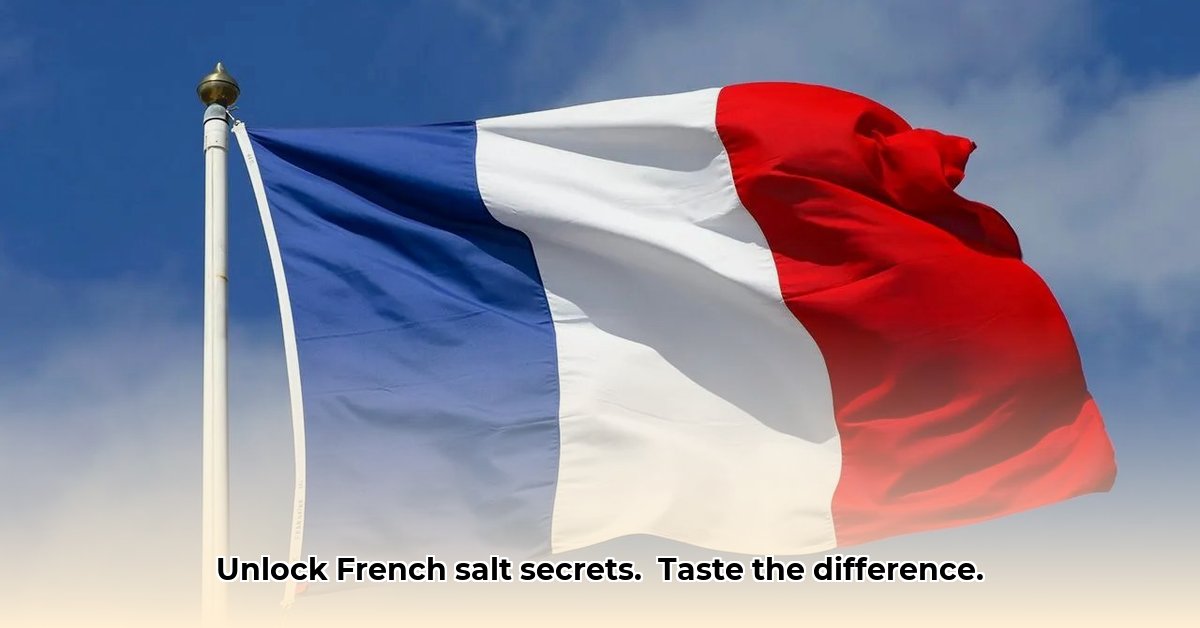Ever tasted a salt so good it practically melts on your tongue? That’s Fleur de Sel, a fancy French sea salt that’s more than just a sprinkle. This guide dives deep into what makes it so special – from how it’s harvested by hand in the sun-drenched salt marshes of France, to its unique, delicate flavor that’s way different from regular table salt. We’ll cover everything you need to know: what gives it such amazing taste, why it costs a bit more, and how to use it like a pro to make your food taste incredible. Whether you’re a kitchen whiz or just starting out, get ready to discover the delicious secrets of Fleur de Sel and level up your cooking game! For more on gourmet tastes, check out this article.
French Salt: Unveiling the Secrets of Fleur de Sel and Beyond
Let’s dive into the fascinating world of French salt, starting with the star of the show: Fleur de Sel. This isn’t your average table salt; it’s a culinary treasure, often called the “flower of salt,” and for good reason. What are the unique qualities that differentiate French salt from the other salts?
The Allure of Fleur de Sel: More Than Just a Pinch of Salt
Fleur de Sel is hand-harvested from the surface of seawater, resulting in delicate, flaky crystals unlike any other. It’s not just about the taste. The slightly higher moisture content gives it a unique texture and a flavor profile that’s far more complex than your standard table salt. Instead of a sharp, intense saltiness, you get something subtler, something more nuanced. Think of it as the caviar of the salt world—a little goes a long way, and it elevates any dish to a new level.
Why the high price tag? Well, it’s all about the painstaking process. It takes skill, time, and perfect conditions to harvest this culinary gem. The salt crystals form naturally on the surface of the water, only on warm, dry days with a gentle breeze. Harvesters, known as “paludiers,” must carefully skim the crystals by hand using a wooden rake called a “lousse à fleur,” before they sink or are broken up by the wind. This artisanal method, passed down through generations, directly impacts the final product’s exceptional taste and texture. This labor-intensive process, combined with the limited quantities that can be harvested, contributes to its higher cost. Are you willing to spend a little more for a gourmet experience?
Harvesting the Flower: A Labor of Love
Imagine a salt marsh bathed in sunshine. The air is thick with the scent of the sea. Highly skilled workers, using traditional tools, gently skim the delicate, newly formed salt crystals from the surface of carefully managed salt pans. It’s a delicate dance between timing and skill—hurry too much, and you risk damaging the crystals; wait too long, and the wind and waves might whisk them away. The harvest is entirely dependent on Mother Nature’s cooperation. This traditional approach—a marriage of human skill and natural conditions—is precisely what creates the unique qualities of true Fleur de Sel. In the Guerande region of France, each salt marsh produces only about 2.2 pounds of Fleur de Sel per day.
Decoding the Flavor: A Symphony on the Tongue
What exactly makes Fleur de Sel so special? It’s not just the saltiness; it’s the kind of saltiness. It’s a more subtle, elegant saltiness, often described as having a hint of minerality—think of the taste of the ocean itself. Depending on the location of the salt pan and the specific conditions during harvesting, some batches may even reveal a subtle sweetness. The trace minerals, such as calcium and magnesium chloride, contribute to its complex taste. Then there’s the texture—incredibly delicate and flaky, it melts almost instantly on your tongue, enhancing the other flavors in the dish instead of overpowering them. What flavors will you detect? The moisture content, which can be up to 10% compared to 0.5% for regular salt, also contributes to the unique way the crystals stick together.
Fleur de Sel vs. the Competition: A Salt Showdown
While Fleur de Sel holds a top spot, several other finishing salts offer interesting alternatives. Each has its own unique character:
| Salt Type | Origin | Texture | Flavor Profile | Price Point | Mineral Content |
|---|---|---|---|---|---|
| Fleur de Sel | France | Delicate, Flaky | Subtle saltiness, minerality, slight sweetness | High | High |
| Maldon Sea Salt | England | Flaky, Pyramidal | Crisp, clean, briny | Medium | Medium |
| Himalayan Pink Salt | Himalayas | Coarse, granular | Mildly salty, slightly sweet | Medium | Medium |
| Sel Gris (Grey Sea Salt) | France (Brittany) | Coarse, Moist | Earthy, mineral-rich, strong saltiness | Medium | High |
| Hawaiian Black Lava Salt | Hawaii | Flaky, Coarse | Bold, earthy, slightly smoky | Medium | Medium |
The table shows clearly that while these other salts offer interesting characteristics, none perfectly replicates the unique profile of Fleur de Sel. Ultimately, the “best” salt depends on your personal taste and what you’re cooking. Is Fleur de Sel worth the premium cost for your cooking style?
Unleashing its Potential: The Art of Using Fleur de Sel
Fleur de Sel is not meant for everyday cooking. Its delicate nature shines as a finishing salt. Sprinkle it lightly after cooking—on roasted vegetables, grilled meats, even a scoop of gourmet ice cream. This way, its subtle flavor enhances without dominating the dish. It’s the perfect final touch, a whisper of elegance that elevates the overall culinary experience. Some popular uses include sprinkling it on chocolate desserts, such as salted caramels and dark chocolate truffles, to enhance the sweetness with a touch of salinity. It’s also excellent on grilled seafood, like scallops or sea bass, bringing out their natural flavors. How will you use it creatively?
Beyond Fleur de Sel: Exploring the Broader World of French Salts
French salt production encompasses more than just Fleur de Sel. Other varieties like Sel Gris (grey salt) bring their own unique culinary personalities. Sel Gris, with its larger crystals and a slightly different mineral profile, adds a different dimension to dishes. Exploring these various types of French salts can add a touch of adventure and culinary innovation to your cooking. You might just discover a new favorite! Sel Gris is harvested from the bottom of the salt pans, giving it a grey color and a higher mineral content compared to Fleur de Sel.
In conclusion, the journey into the world of French salt is a delicious and enlightening adventure. Each variety holds a unique story, reflecting the land and the traditional methods that shaped its creation. It’s more than just a seasoning; it’s an experience that elevates both the taste and the art of cooking. So, why not embark on a culinary exploration to discover your perfect French salt?
How to store Fleur de Sel to preserve its unique flavor and texture
Key Takeaways:
- Airtight storage is crucial to prevent moisture absorption and clumping.
- A cool, dark, and dry location is ideal for optimal preservation.
- Glass or ceramic containers are generally preferred over plastic to avoid potential leaching or odor absorption.
- Using fleur de sel within a year ensures the best flavor and texture.
- Consider adding a desiccant, such as silica gel packets or rice, to further reduce moisture.
Understanding Fleur de Sel’s Delicate Nature
Fleur de sel, the “flower of salt,” isn’t just any salt; it’s a culinary treasure. Hand-harvested from the surface of salt marshes, its delicate, flaky crystals hold a unique, complex flavor profile that’s easily compromised. Think of it like a fine wine – it needs proper care to retain its exquisite qualities. So, how to store Fleur de Sel to preserve its unique flavor and texture is a question worth exploring.
The Enemies of Exquisite Flavor: Moisture, Light, and Heat
Moisture is the biggest enemy of fleur de sel. Exposure to humidity causes clumping, diminishing its delicate texture and subtly altering its taste. Light and heat aren’t far behind. Prolonged exposure to sunlight or high temperatures can degrade the salt’s mineral composition and affect its flavor profile over time. You wouldn’t leave a prized bottle of vintage wine in direct sunlight, would you?
Optimal Storage: A Simple Guide
To maintain the superior quality of your fleur de sel, follow these simple, yet crucial, steps:
-
Choose the Right Container: Airtight containers are paramount. Many prefer glass or ceramic for their inert nature. However, high-quality food-grade plastic containers also work well. Avoid containers that might impart odors or off-flavors. Make sure the lid seals tightly to prevent any moisture from entering.
-
Location, Location, Location: Store your fleur de sel in a cool, dark, and dry place, ideally in your pantry, away from heat sources and direct sunlight. Think of it as a sanctuary for your delicate sea salt. A temperature between 60-70°F (15-21°C) is ideal.
-
Consider Desiccants: For extra insurance, placing a small packet of silica gel or even a few grains of uncooked rice in the
- Smart Meal Prep Recipes Gluten Free for Dietary Needs - November 29, 2025
- Gluten Free Meal Prep Ideas for Delicious, Hassle-Free Eating - November 28, 2025
- Gluten Free Meal Prep for Stress-Free and Healthy Eating - November 27, 2025










